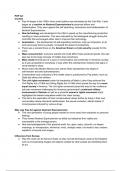POP Art
Context
● Pop Art began in the 1950’s when world politics was dominated by the Cold War. It also
began as a reaction to Abstract Expressionism’s perceived elitism and
intellectualism. They were against the self searching, introversion and intellectualism of
Abstract Expressionism.
● New technology was developed in the USA to speed up the manufacturing production
resulting in mass production. This was motivated by the Ideological struggle during the
Cold War that encouraged either side to improve their technology.
● Automation - the development of self-regulating machines, such as computers, to do
work previously done by people, increased the speed of productivity.
● There was a societal focus on the American Dream and job security (usually for the
men).
● Mass consumerism: everyone wanted and could afford mass produced goods, this was
also due to the huge increase of middle class Americans.
● Mass media formed part of a wave of conservatism and conformity in American society,
as it was accessible to everybody. It was within the entertainment industry that signs of
revolt started to show.
● Movie actors like Marilyn Monroe and James Dean represented new ideals of
anti-heroism and anti-authoritarianism.
● Conservatism and conformity of the middle class is questioned by Pop artists, much as
Dada did without the nihilism.
● The civil rights movement under the leadership of Martin Luther King achieved the
Civil Rights Act of 1964 and Voting Rights Act of 1965 which paved the way for a more
equal society in America. The civil rights movement paved the way for the vociferous
anti-war movement challenging the American government's continued military
involvement in Vietnam as well as a powerful women's rights movement which
highlighted the blatant inequalities within this 'ideal' society.
● This led to the exploration of their countercultural values further by living in their own
communities where interracial relationships, the sexual revolution, altered states of
consciousness induced by various drugs.
Why was Pop Art against Abstract Expressionism
● This new generation of young people wanted to move away from emphasis on personal
feelings.
● They viewed Abstract Expressionism as elitist and detached from reality and
inaccessible to the average person.
● New acknowledgement of the physical world: fun, glam, tacky, colourful, no deeper
meanings, no introspection, whimsical, ironic, cheaply made, not made to last, modern,
repetition of sounds and images.
Influences from Europe
● Pop Arts roots can be found in Dada, as they revived techniques used by the Dadaists
such as incorporating images and objects created by other people and exhibiting them
as art.
, ● While the Dadaists used their art to oppose conservative interpretations of aesthetic
beauty, the Pop artists developed gestures of opposition to the art establishment by
representing aspects of modern life.
● Pop art was not an anti-art movement as they did not commit to any specific agenda or
philosophy.
The beginning of POP Art in Britain
● In 1954 a British art critic first used the word POP to describe art inspired by the imagery
of popular culture. He was referring to artworks created by a collective of artists,
architects and writers in Britain, known as the Independent Group.
● They explored ideas concerning the place of consumer culture in fine art, the use of
found objects and science and technology. Imagery from the popular American
consumer culture, such as covers of science fiction magazines, comic strips, pin-ups,
movie posters, photojournalism, car designs and machines, were the main source of
their interest.
● In a letter Hamilton also defined Pop Art as popular, transient, expendable, low-cost,
mass-produced, young, witty, sexy, glamorous, and Big Business.
The beginning of POP Art in America
● It gradually grew out of Abstract Expressionism and it was not until 1961 that the New
York art scene realised the impact of Pop Art.
● Mass media imagery seemed to the Europeans to have an exotic glamour and to the
Americans it seemed banal and commonplace.
● This resulted in artworks that attempted to identify and define the essence of
Americanism through the lowest common denominators that posed ambivalent and
provocative questions about popular imagery as well as the state of visual art itself.
● Initially Pop Art was dismissed by the American art world. The art critic Rosenberg
dismissed it and said that because it was illusionistic, it was easier to talk about. This
was true as Pop Art was a commercial success in the galleries. The public could
understand it.
Characteristics:
Pop Art represents the reality of everyday objects by referring to images and objects that
people have experienced during their daily lives. Pop Art was not trying to be satirical or
critical and can instead be seen as an avant garde modern art movement. It is an affirmation
of modern life, making people aware of the world around them.
Shape: Hard edged shapes with a limited representation of three-dimensional depth, were
synonymous with images from advertising and cartoons. Other artists used a more
expressive style and in their works the shapes are more three-dimensional.
Application: The more expressive textural application of paint seen in some works are not
typical of the majority of the Pop artworks. Characteristic of most Pop Art is the smooth
application of paint showing no individualistic, expressive signs of emotion. This reflects the




